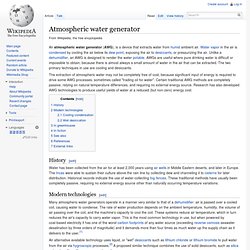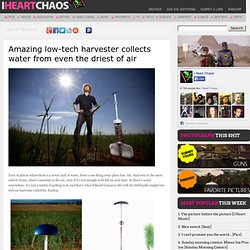

Atmospheric water generator. An atmospheric water generator (AWG), is a device that extracts water from humid ambient air.

Water vapor in the air is condensed by cooling the air below its dew point, exposing the air to desiccants, or pressurizing the air. Unlike a dehumidifier, an AWG is designed to render the water potable. AWGs are useful where pure drinking water is difficult or impossible to obtain, because there is almost always a small amount of water in the air that can be extracted. The two primary techniques in use are cooling and desiccants. The extraction of atmospheric water may not be completely free of cost, because significant input of energy is required to drive some AWG processes, sometimes called "trading oil for water". History[edit] Modern technologies[edit] Many atmospheric water generators operate in a manner very similar to that of a dehumidifier: air is passed over a cooled coil, causing water to condense. Cooling condensation[edit] Example of cooling-condensation process.
Wet desiccation[edit] Amazing low-tech harvester collects water from even the driest of air. Even in places where there’s a severe lack of water, there’s one thing every place has.

Air. And even in the most arid of climes, there’s moisture in the air, even if it’s not enough to be felt on your skin. So there’s water everywhere, it’s just a matter of getting to it, and that’s what Edward Linnacre did with his brilliantly simple low tech air harvester called the Airdrop. With a deceptively modest design, Airdrop filters hot environmental air through a turbine, feeding it through a copper tubing system—with copper wool to maximize surface area—and into the earth where it cools and releases moisture. The dry air is then re-released into the atmosphere and the collected water pumped through semi-porous hoses to the plant roots.
Okay, that’s just genius and badass. Via. Billboard in Peruvian desert turns air humidity into drinking water. How To Get Fresh Water Out Of Thin Air. Image Credit: MIT Fog-harvesting system developed by MIT and Chilean researchers could provide potable water for the world’s driest regions.

CAMBRIDGE, Mass. — In some of this planet’s driest regions, where rainfall is rare or even nonexistent, a few specialized plants and insects have devised ingenious strategies to provide themselves with the water necessary for life: They pull it right out of the air, from fog that drifts in from warm oceans nearby. Drinking Water out of Air. Smart Billboard That Produces Drinkable Water From Air. MIT Fog Harvesting Material Yields 5x More H20. Gulf countries like Abu Dhabi may lack freshwater resources, but they also have a lot of humidity.

MIT’s new super efficient fog harvesting material could help countries with climates like this capture that moisture for drinking water. Fog harvesting is modeled after creatures like the Namib Beetle that are well adapted to pulling moisture out of the air – even in extraordinarily dry conditions like the desert. Water Plants With Your Air Conditioner. Fog Harvesting. Drinking Water From Air Humidity. Not a plant to be seen, the desert ground is too dry.

But the air contains water, and research scientists have found a way of obtaining drinking water from air humidity. The system is based completely on renewable energy and is therefore autonomous. Cracks permeate the dried-out desert ground, the landscape bears testimony to the lack of water. But even here, where there are no lakes, rivers or groundwater, considerable quantities of water are stored in the air.
In the Negev desert in Israel, for example, annual average relative air humidity is 64 percent – in every cubic meter of air there are 11.5 milliliters of water. Research scientists at the Fraunhofer Institute for Interfacial Engineering and Biotechnology IGB in Stuttgart working in conjunction with their colleagues from the company Logos Innovationen have found a way of converting this air humidity autonomously and decentrally into drinkable water. “The concept is suitable for various sizes of installation.